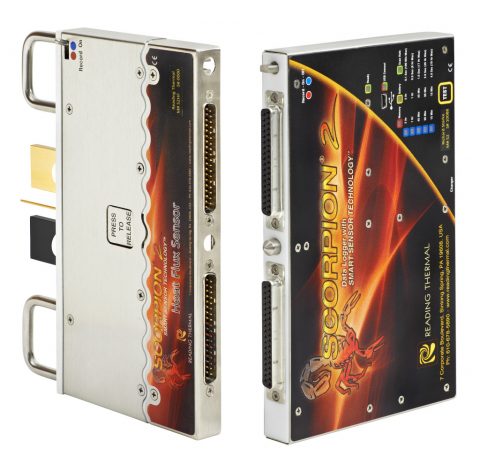By utilizing thermal profiling technology to optimize your cracker production ovens with the help of Reading Thermal profiling systems, you will gain information that can be used to make reliable data-based decisions about your processes and products.
Reading Thermal, headquartered in Sinking Spring, Pennsylvania, has focused on researching, measuring and understanding the commercial baking process for more than 25 years. Our SCORPION® 2 Profiling System enables bakeries to monitor actual in-process conditions and get the critical information they need to correct problems and maintain optimum process control.
Measuring Oven Temperature
If you manufacture bread, biscuits, crackers, rolls, hamburger buns, cakes, or other bread products, you know that several stages of the process are temperature-dependent, such as oven-spring, drying/dehydration, and color formation.
Too much heat emanating from one direction can cause the bottoms of the products to burn before the crusts brown properly. Insufficient or excessive heat can also lead to unwelcome changes in texture and taste.
The Scorpion® 2 Temperature Sensor Array measures the temperature at product level, in fixed positions across the conveyor, and delivers a precise picture of temperatures from side-to-side and end-to-end.
Other Important Sensor Measurements
Connecting smart sensors and sensor arrays to the SCORPION® 2 Profiling System and passing them through the oven with the product, enables the measurement system to capture the four main baking parameters:
Heat Flux (Energy Transfer)
Certain product characteristics are defined by the amount and type of heat applied during the baking process. The differences explain why one oven bakes differently than another. Analyzing and controlling these differences is critical to understanding how the finished characteristics of your products will be affected. The SCORPION® 2 Heat Flux Sensor measures radiant and heat fluxes at product level and displays the results in Btu/hr·ft2 or convective W/m2.
Humidity
Humidity is the amount of water vapor in the air. As your products bake, they use the available moisture in your oven. Without humidity, the quality and texture of your products will not turn out as expected. High humidity in the oven can lighten the crust color of baked goods and prevent it from burning. Lower humidity typically results in crustier bread. Global bakeries trust the SCORPION® 2 Digital Humidity Sensor, to accurately measure the absolute moisture content of the thermal environment in heating and cooling processes.
Air Velocity
Air velocity is the measurement of airflow inside the oven. Along with other parameters, air velocity influences the coloration, texture, firmness, and baking time of your final product. It can be measured and recorded with the SCORPION® 2 Air Velocity Sensor. The sensor array delivers a precise picture of airflow patterns inside the oven. The sensors collect data, at product level, as the array travels through the oven. The number of sensors required will vary with the width of the conveyor.
Optimizing your cracker production ovens with thermal profiling may be the answer if you are experiencing inconsistent product quality. You can count on the state-of-the-art Reading Thermal SCORPION® 2 Data Logger and our various sensors and sensor arrays. Contact us online, or call our headquarters in Sinking Spring, Pennsylvania at (610) 678-5890 Ext. 2 to learn more about our innovative products.

